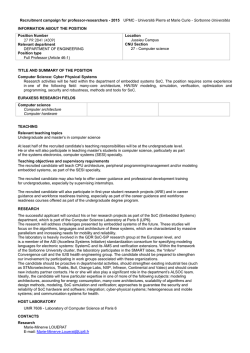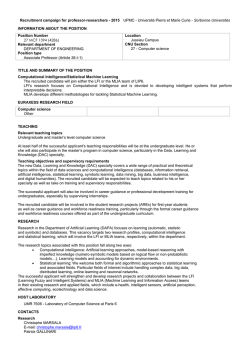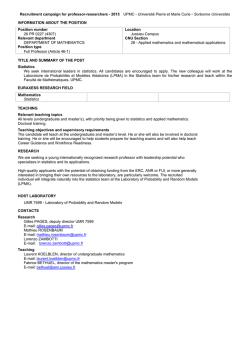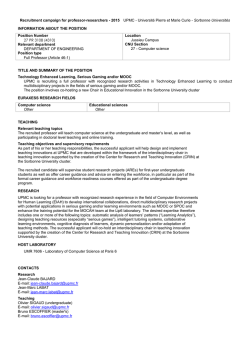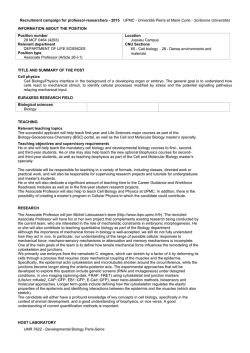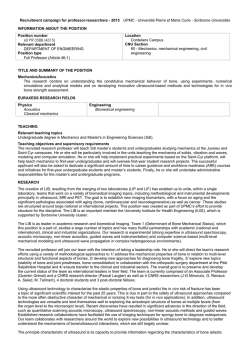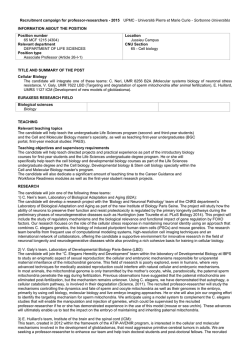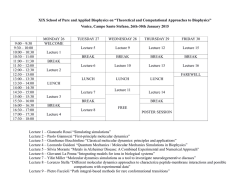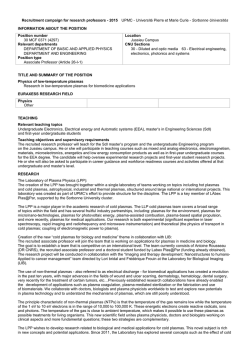
Molecular complexity in the universe
Recruitment campaign for professor-researchers - 2015 UPMC - Université Pierre et Marie Curie - Sorbonne Universités INFORMATION ABOUT THE POSITION Position number 30 MCF 1090 (4296) Relevant department DEPARTMENT OF BASIC AND APPLIED PHYSICS Position type Associate Professor (Article 26-I-1) Location Jussieu Campus CNU Sections 34 - Astronomy, astrophysics 30 - Diluted and optic media TITLE AND SUMMARY OF THE POST Molecular complexity in the universe The origin and evolution of molecular complexity in the Universe, from interstellar clouds to stars and planets; interfaces between observations, modeling and laboratory astrophysics. EURAXESS RESEARCH FIELDS Astronomy Other Physics Other TEACHING Relevant teaching topics All levels of physics training from undergraduate to master’s students Teaching objectives and supervisory requirements The successful applicant will teach general physics to undergraduate and master’s students. He or she will eventually contribute to teaching astrophysics (courses, directed work or practical work observations). The recruited candidate will help refresh our current teaching practices and provide career guidance to students. RESEARCH The new Laboratory for the Study of Radiation and Matter in Astrophysics (LERMA), which was formed by merging LERMA and LPMAA in January 2014, is a multidisciplinary laboratory whose activities are organized around four scientific poles: (1) Galaxies and cosmology, (2) The dynamics of the interstellar environments and stellar plasmas, (3) Molecules in the universe, (4) Instrumentation and remote sensing (THz). The broad range of LERMA’s activities, which encompass astrophysics, physics and engineering sciences, inspires the development of original research in each individual field and promotes combined teaching in physics, engineering, applied mathematics or high-performance computing, as well as with industrial partners. LERMA is actively involved in three Labex physics projects at UPMC that have a strong link to astrophysics, including the Lagrange Institute of Paris, the Plas@Par networks and MIChem, demonstrating the depth of the teams’ commitments, in line with the strong scientific policies of the University. Digital or experimental models are indispensable for analyzing physical systems that are too complex for simple mechanical modeling. LERMA, a leader in these fields, is actively engaged in developing and using digital simulations, particularly in collaboration with the Institute of Computing and Simulation, as well as the rapid rise of laboratory-based astrophysics at the European level (the European Task Force for Laboratory Astrophysics, http://www.labastro.eu/). The purpose of the advertised position is to reinforce the potential for astrophysics research along one of LERMA’s scientific poles, in one of the subject areas in which the new laboratory has established a recognized leadership, particularly: the physics of the interstellar environment and star formation, the dynamics of accretion and ejection processes, turbulence and magneto-hydrodynamic (MHD) shocks, coupling microphysical processes to non-linear fluid dynamics, the origin and evolution of molecular complexity in the universe and the study of molecular tracers and diagnostics. The candidate should therefore be able to contribute to ambitious projects, such as: - The function and use of programs at very large international observatories; - Understand the coupling of microscopic processes to environmental dynamics (for instance, reactive MHD flow or the effects of opacity on environments); - The laboratory astrophysics: studying molecular processes at the gas-grain interface or in very dilute environments (isotopic fractionation, the effects of UV radiation, collisional processes, etc…) or the study of plasmas in the laboratory; - Developing powerful computational models of multiphase flow in the interstellar medium, including the precise details of heat transfer and reactive processes, to study the formation and evolution of astrophysical objects. Applications that link multiple scientific poles are encouraged, as they will reinforce the complementarities that are LERMA’s strength, particularly synergies between observations made using world-class instrumentation (using data from the Herschel and Planck satellites, new IRAM and ALMA projects, VLT, and later NOEMA, ELT or JWST,…) modeling and laboratory experiments in molecular astrophysics. HOST LABORATORY UMR 8112 - Laboratory for the Study of Radiation and Matter in Astrophysics (LERMA) CONTACTS Research M. Darek LIS, director of LERMA Telephone: 01 40 51 20 53 E-Mail: [email protected] Teaching M. Edouard KIERLIK, director of the Physics faculty E-Mail: [email protected] MANDATORY INSTRUCTIONS FOR PREPARING YOUR APPLICATION As UPMC has opted for a paperless application procedure, please ensure that you follow the instructions below exactly to facilitate optimal handling of your application. Candidate registration will involve two steps: ● 1st step: from 10 am Monday, February 2, 2015 to 4 pm Tuesday, March 10, 2015 REGISTER your candidacy using the GALAXIE application, which can link: https://galaxie.enseignementsup-recherche.gouv.fr/antares/can/astree/index.jsp be found at the following ● 2nd step: from 10 am Monday, February 2, 2015 to midnight on Tuesday, March 10, 2015 REGISTER AND UPLOAD ALL FILES for your application at the following link: http://concours.upmc.fr The application must contain the following items, according to the current regulations (decrees of October 7, 2009), in PDF format: 1. a dated and signed declaration of candidacy, which can be downloaded on GALAXIE; 2. a clear copy of photo identification, front and back; 3. a curriculum vitae (cf. article 10 of title IV of the decree of October 7, 2009); 4. a diploma: doctorate, HDR (habilitation à diriger des recherches) or equivalent; 5. the thesis committee report approving the thesis defense/viva; 6. at least one representative example of the work, publications, articles and achievements cited in the CV; 7. additionally, for candidates who are applying in these cases: 7a) as a transfer: certification from the original institution confirming the quality of the professor or lecturer and active performance of the duties associated with the position for at least three years by the closing date for applications; 7b) for a secondment: recent certification from the current employer citing which category the candidate falls into as outlined by article 58-1 of decree No. 84-431 of June 6, 1984 concerning the status of research professors and the quality of the position holder in the context of the original position for at least three years at the closing date for applications; 7c) as a professor-researcher who holds a similar position in a country other than France that is equivalent to the advertised position and is therefore exempt from evaluation based on the list of qualifications: recent certification from the current employer citing the institution that the candidate belongs to, the duration of employment and the level of duties performed; 7d) under article 46-3: certification from the original employer establishing the quality of the full professor or associate professor as regulated by decree No. 84-431, modified on June 6, 1984, and the duration of employment, in accordance with article 46-3 of the aforementioned decree. Administrative documents in foreign languages must be translated into French. All relevant information regarding the professor-researcher recruitment can be found on the UPMC website at the following address, under the heading ACTUALITES (NEWS): http://www.upmc.fr If you have any questions, you can contact the administrative team at [email protected]. PAPER APPLICATIONS WILL NOT BE ACCEPTED
© Copyright 2024
